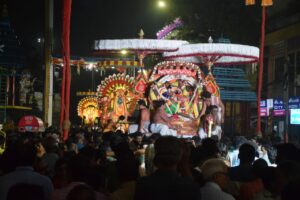Tamil inscriptions through the aeons, especially the Vijayanagar-period inscriptions, refer to the celebration of Panguni Uthiram.

Representational image. (iStock)
Panguni Uthiram is celebrated during the full moon in the last Tamil month of Panguni, corresponding to the period between mid-March and mid-April.
Many divine marriages occur on this auspicious day, such as Parvati and Siva, Valli and Murugar, Andal and Rangamannar, and Sita and Rama.
In Tamil Nadu, it is a ten-day festival in most temples, with the divine marriage on the last day.
The celebration of Panguni Uthiram is documented in Tamil Sangam literature, roughly from the third century.
Uraiyur (today’s Tiruchirappalli) was the ancient capital of the early Chola kings.
Agananooru, a Sangam literature piece, carries a song about the Panguni Uthiram celebrations in Uraiyur.
The festival is called ‘Panguni Muyukkam’ and symbolizes the festive mood of the people of Uraiyur.

During the festival, many people gather and cook with great relish. Another Sangam literature work, Purananooru, also mentions the Panguni Uthiram festival.
Around the seventh century, a wealthy merchant named Sivanesa Chettiar lived in Chennai, Mylapore. He desired to get his daughter Poombavai married to the famous Nayanmar (saints who were devoted to Lord Siva) Sambandar.
Unfortunately, she was bitten by a snake, which ended her life. Chettiar preserved her bones and handed them over to Sambandar.
Sambandar, who had arrived in Thiruvotriyur in Chennai, learned about this and came to Mylapore. Sivanesa Chettiar handed Poombavai’s bones preserved in a kalasam to Sambandar.
Sambandar sang hymns, praying to Lord Kapaleeswarar in Mylapore to bring back Poombavai’s life. These verses are called ‘Poompavai Pathigam’ and are part of the Saivite poems called ‘Thevaram’.
In one of the verses, Sambandar mentions the glorious Panguni Uthiram festival celebrated in the big streets of Mylapore.
The beauty in these verses is that Sambandar questions Poompavai, saying, “Is it right for you to end your life without seeing the Mylapore Panguni Uthiram festival?”
Also read: Jallikattu season
Even today, Panguni Uthiram is the magnificent festival of the iconic Kapaleeswarar temple in Mylapore of Chennai. Notably, the revival of Poompavai was also enacted during the festival, and Sambandar sang hymns.
Another Nayanmar, Thirunavukarasar, of the seventh century, details Panguni Uthiram celebrations in Thiruvaroor.
Twelfth-century Sekkizhar also mentions Panguni Uthiram celebrations in Tiruvaroor. Kulothunga Chola inscriptions in roughly the same period also elaborate on the ten-day Panguni Uthiram festival here.
Thirunavaukarasar’s Thevaram on Chennai Thiruvotriyur informs us about the elaborate festival in Thiruvotriyur during Panguni Uthiram and how the entire place sparkled with lights.
A twelfth-century epigraphic record in Thiruvotriyur temple confirms this information.
It records the presence of King Rajadhiraja Chola II on the occasion of the Panguni Uthiram festival in Thiruvotriyur, along with Chaturanana Pandita, who owned a math in Thiruvotriyur, and Vagiswara Panditha, who expounded the Soma siddhanta (doctrine of the Kapalika Saivas).
During the visit, they heard the story of the Saivite poet Sundarar.
The eighteenth-century Tamil work Iraiyanaar Kalaviyal specifies Panguni Uthiram, celebrated in the early Chola capital Uraiyur, as one of the biggest festivals celebrated by the three important Tamil dynasties, namely the Chera, Chola, and Pandya.
Tamil inscriptions throughout all periods talk about the Panguni Uthiram festival. Especially many Vijayanagar period inscriptions across the Tamil region carry detailed information about the festival.
The earliest inscription on the festival could be from the 10th century in Srirangam. The inscription details the nine-day Panguni Uthiram festival ceremonies and offerings during the Parantaka Chola period.
Srirangam’s Panguni Uthiram festival is famous to this day; even the divine wedding mandapam is named ‘Panguni Uthira Mandapam’.
Seventeenth-century Tamil work Mookudarpallu also talks about the grand Panguni festival in Koodal Azhagar Vishnu temple.
Appam, Paruppu Ponagam, Vadai and Payasam are unique dishes offered during Panguni Uthiram. In Madurai, ‘ Paal Maangai’ is an essential offering for Panguni Uthiram.
Panguni Uthiram has been a prominent festival for nearly two thousand years. The most outstanding fact of this festival is that it has been glorified throughout all timelines with the same grandeur.
Even today, it is still celebrated with pomp and enthusiasm among the Tamil devotees with rich ritual processions and grand divine marriages.
(The writer is a Tamil historian who has written many research articles on the social, cultural, and religious practices of ancient Tamil Nadu. An ardent kolam artist, she has created many Chikku kolam patterns on various aspects of Tamil culture. Views are personal.)

Jul 26, 2024

Jul 26, 2024

Jul 24, 2024

Jul 24, 2024

Jul 19, 2024

Jul 18, 2024